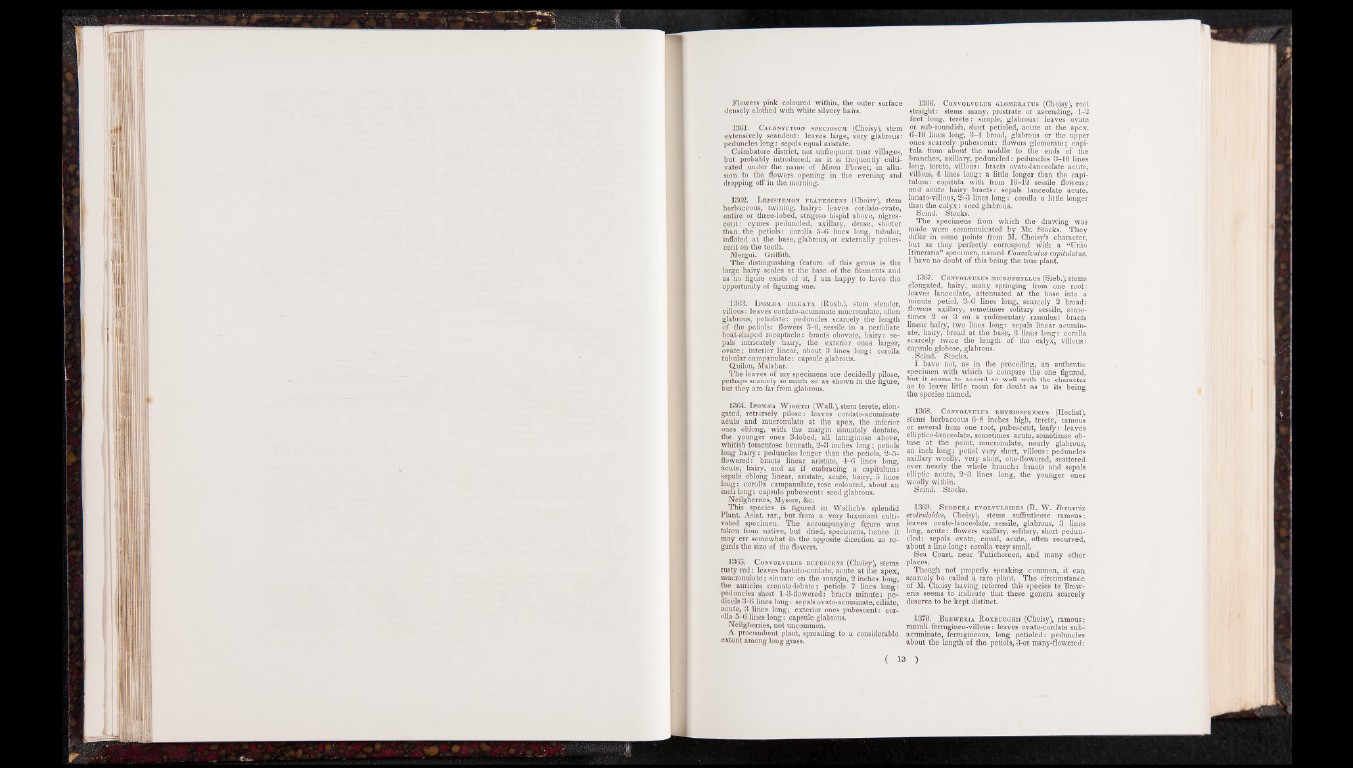
Flowers pink coloured within, the outer surface
densely clothed with white silvery hairs.
1361. Calonyction speciosum (Choisy), stem
extensively scandent: leaves large, very glabrous:
peduncles long: sepals equal aristate.
Coimbatore district, not unfrequent near villages,
but probably introduced, as it is frequently cultivated
under the name of Moon Flower, in allusion
to the flowers opening in the evening and
dropping off in the morning.
1362. Lepistemon flavescens (Choisy), stem
herbaceous, twining, hairy: leaves cordato-ovate,
entire or three-lobed, strigoso hispid above, nigrescent:
cymes peduncled, axillary, dense, shorter
than the petiols: corolla 5 -6 lines long, tubular,
inflated at the base, glabrous, or externally pubescent
on the teeth.
Mergui. Griffith.
The distinguishing feature of this genus is the
large hairy scales at the base of the filaments and
as no figure exists of it, I am-happy to have the
opportunity of figuring one.
1363. I pomasa fileata (Roxb.), stem slender,
villous: leaves cordato-acuminate mucronulate, often
glabrous, petiolate: peduncles scarcely the length
of the petiols: flowers 5-6, sessile in a perfoliate
boat-shaped receptacle: bracts obovate, hairy: sepals
intricately hairy, the exterior ones larger,
ovate; interior linear, about 3 lines long: corolla
tubular campanulate: capsule glabrous.
Q,uilon, Malabar.
The leaves of my specimens are decidedly pilose,
perhaps scarcely so much so as shown in the figure,
but they are far from glabrous.
1364. I p omasa W ightii (Wall.), stem terete, elongated,
retrorsely pilose: leaves cordato-acuminate
acute and mucronulate at the apex, the inferior
ones oblong, with the margin sinuately dentate,
the younger ones 3-lobed, all lanuginose above,
whitish tomentose beneath, 2 -3 inches long; petiols
long hairy: peduncles longer than the petiols, 2-5-
flowered: bracts linear aristate, 4-6 lines long,
acute, hairy, and as if embracing a capitulum:
sepals oblong linear, aristate, acute, hairy, 5 lines
long: corolla campanulate, rose coloured, about an
inch long: capsule pubescent: seed glabrous.
Neilgherries, Mysore, &c.
This species is figured in Wallich’s splendid
Plant. Asiat. rar., but from a very luxuriant cultivated
specimen. The accompanying figure was
taken from native, but dried, specimens, hence it
may err somewhat in the opposite direction as regards
the size of the flowers.
1365. Convolvulus rufescens (Choisy), stems
rusty red: leaves hastato-cordate, acute at the apex,
mucronulate; sinuate on the margin, 2 inches long,
the auricles crenato-lobate; petiols 7 lines long:
peduncles short 1-3-flowered: bracts minute: pedicels
3-6 lines long: sepals ovato-acuminate, ciliate,
acute, 3 lines long; exterior ones pubescent: corolla
5 -6 lines long: capsule glabrous.
Neilgherries, not uncommon.
A procumbent plant, spreading to a considerable
extent among long grass.
1366. Convolvulus glomeratus (Choisy), root
straight: stems many, prostrate or ascending, 1-2
feet long, terete; simple, glabrous: leaves ovate
or sub-roundish, short petioled, acute at the apex,
6-10 lines long, 3 -4 broad, glabrous or the upper
ones scarcely pubescent: flowers glomerate; capi-
tula from about the middle to the ends of the
branches, axillary, peduncled: peduncles 3-10 lines
long, terete, villous: bracts ovato-lanceolate acute,
villous, 4 lines long; a little longer than the capitulum:
capitula with from 10-12 sessile flowers;
and acute hairy bracts : sepals lanceolate acute,
lanato-villous, 2 -3 lines long: corolla a little longer
than the calyx: seed glabrous.
Scind. Stocks.
The specimens from which the drawing was
made were communicated by Mr. Stocks. They
differ in some points from M. Choisy’s character,
but as they perfectly correspond with a “Unio
Itineraria” specimen, named Convolvulus capitulatus,
I have no doubt of this being the true plant
1367. Convolvulus microphtllus (Sieb.), stems
elongated, hairy, many springing from one root:
leaves lanceolate, attenuated at the base into a
minute petiol, 3 -6 lines long, scarcely 2 broad:
flowers axillary, sometimes solitary sessile, sometimes
2 or 3 on a rudimentary ramulus: bracts
linear hairy, two lines long: sepals linear acuminate,
hairy, broad at the base, 3 lines long: corolla
scarcely twice the length of the calyx, villous:
capsule globose, glabrous.
Scind. Stocks.
I have not, as in the preceding, an authentic
specimen with which to compare the one figured,
but it seems to accord so well with the character
as to leave little room for doubt as to its being
the species named.
1368. Convolvulus rhyniospermus (Hochst),
stems herbaceous 6 -8 inches high, terete, ramous
or several from one root, pubescent, leafy: leaves
elliptico-lanceolate, sometimes acute, sometimes obtuse
at the point, mucronulate, nearly glabrous,
an inch long; petiol very short, villous: peduncles
axillary woolly, very short, one-flowered, scattered
over nearly the whole branch: bracts and sepals
elliptic acute, 2 -3 lines long, the younger ones
woolly within.
Scind. Stocks.
1369. S eddera evolvuloides (R. W . Breweria
evolvuloides, Choisy), stems sufiruticose ramous:
leaves ovato-lanceolate, sessile, glabrous, 3 lines
long, acute: flowers axillary, solitary, short peduncled:
sepals ovate, equal, acute, often recurved,
about a line long: corona very small.
Sea Coast, near Tutichoreen, and many other
places.
Though not properly speaking common, it can
scarcely be called a rare plant. The circumstance
of M. Choisy having referred this species to Breweria
seems to indicate that these genera scarcely
deserve to be kept distinct.
1370. Breweria R oxburghii (Choisy), ramous;
ramuli ferrugineo-villous: leaves ovato-cordate subacuminate,
ferrugineous, long petioled: peduncles
about the length of the petiols, 3-or many-flowered: